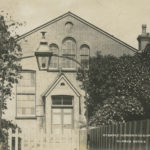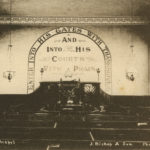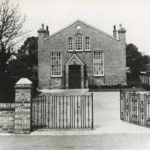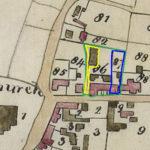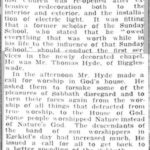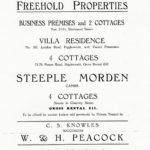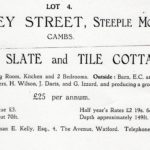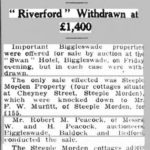Methodist Chapel
From 1823, the Methodists held regular services in their barn chapel behind the Waggon and Horses, until the Trustees were able to acquire a plot of land in 1835 in Cheyney Street. It was a piece of back land, lying behind a couple of cottages that abutted the street. On this plot of a mere 11 perches they resolved to build a chapel.
In the Women’s Institute Village Scrapbook March 1958 it says “The land upon which the Chapel is built was given by a Mr Strickland, who lived at Victoria House.” Well, not exactly? The Trustees bought the land for £30 from Thomas Strickland, brewer of Potton, Beds.
He also owned the two cottages at the front, which left the only access to the new chapel via a 6ft wide passage from Cheyney Street. The Tithe Map 1839 below, shows the Chapel on parcel 83 [number illegible on image], with two cottages in front of the Chapel, plus a further two cottages to the right/east, which are now 7 Cheyney Street, all on Parcel 86. Parcel 87 is now 11 Cheyney Street, Homedale. All the land, plots 86 and 87, edged in red belonged to Thomas Strickland and details from the Tithe Apportionment are:
| Parcel | Owner | Occupier | Description | Extent |
| 83 | Trustees of Meeting | Trustees of Meeting | Meeting and yard | 0a 0r 11p |
| 86 | Thomas Strickland | Samuel Christmas and others | Cottage and garden | 0a 1r 2p |
| 87 | Thomas Strickland | Thomas Strickland | Cottage and garden | 0a 0r 22p |
It is not certain, when building of the Chapel was completed, although certainly before 1839 and it was a substantial replacement for the thatched barn and had 400 sittings. Details of its construction and opening, presumably to much ceremony, have not been found, although it is believed that a key element of funding was each Methodist giving 3d a week towards the building fund over the years. The Methodist Church enjoyed a considerable following through the 19th Century and and well into the 20th, with many tradespeople and those active in village affairs prominent in their support. In the Religious Census of 1851 it was claimed that the average attendance was 200 adults, with 300 in the afternoons, plus 100 Sunday school pupils.
In 1873 the Church claimed to have 400 members, roughly half the adult population and in 1875 the Chapel was extended with a Vestry and Schoolroom being added. By 1885 membership was said to be 500. The Chapel had an active Sunday School for many years. when it would have played a wider role in children’s education than religion alone.
Writing in the 1958 WI Scrapbook, it was recorded that at that time Sunday services were held at 2.30pm and 6pm. A Women’s Bright Hour met at 3pm every Thursday afternoon during the winter months and there was also a Methodist Guild. A Library had been started about 1875, with a weekly subscription of 1/2d, although this was no longer active in 1958.
In 1937 the cottages lying between the chapel and Cheyney Street were bought by Beatrice Emily Franklin, widow of William Franklin, who lived at Home Farm across the road and she expressed a wish that the Methodists should have the cottages, so they could open up both access and aspect of the Chapel. She died in 15 April 1943 and her executors gave the first cottage to the Chapel Trustees in 1948 and the second in 1952. It is not apparent what predicated the timing and sequencing of the transfer of the cottages and why it was not effected in a single transaction. The cottages had been demolished by 1955, although final clearing of the site and concreting it to form a car park, with a brick boundary wall erected alongside the road and access via a pair of wrought iron gates, was not completed until 1958. At last the Chapel was fully visible from the street.
Towards the end of the 20th century, chapel attendance reduced and a number of stalwarts died, leaving the dwindling number of members to eventually take the difficult decision to close and sell the chapel. It was simply too large for the much reduced congregation and the cost of maintenance was heavy. It closed in 2006 and the contents and fixtures were offered to parishioners in return for a donation. We have two pews from the chapel, plus the organist’s bench and there must be a number of mementoes around the village. On 12 April 2007 Planning Approval was granted for change of use from Church to Private Dwelling.
Surprisingly, the Methodist Chapel is not and has never been a listed building.
Deeds
Deeds for the purchase of the land for the Chapel in 1835 and appointment of trustees 1860
Lease and Release of Freehold Land for Methodist Chapel. Thomas Strickland to Charles Smith and Others
18/19 September 1835 – Abstract
Lease for one year – Thomas Strickland to Charles Smith and others. 18 September 1835.
Release – Indenture made 19 September 1835, between
First Party:
Thomas Strickland of Potton, Beds., brewer
Second Party:
Charles Smith of Potton, Beds., shoemaker
James Judd of Potton, Beds., draper
Thomas Hine of Newnham, Herts., yeoman
William Conquest of Biggleswade, Beds., shoemaker
John Britten of Biggleswade, Beds., druggist
John Conquest of Biggleswade, Beds., schoolmaster
Thomas Powers of Biggleswade, Beds., ironmonger
James Lilley of Gt Morden, yeoman
John Christy of Weston, Herts., yeoman
Charles Charter of Steeple Morden, yeoman
William Garrard of Ashwell, Herts., tailor
Third Party:
Jonathan Turner of Biggleswade, Beds., superintendent preacher of the circuit in which land situate
Whereas by indentures of lease and release dated 19/20 November 1832 the release being made between
First Party:
William Betts Thurley and Elizabeth his wife
Second Party:
John Thomas Church
Third Party:
Charles Hirst
Fourth Party:
Thomas Strickland
And by virtue of a common recovery suffered in the Court of Common Pleas at Westminster in Michaelmas Term of the 4th year of King’s Reign, in which recovery Charles Hirst was demandant, John Thomas Church tenant, William Betts Thurley and his wife Elizabeth first vouches and George Humphreys common vouchee, all that piece of land later described to Thomas Strickland and his assigns during his natural life and with remainder, to the use of Charles Hirst and his heirs during the life of and in trust for Thomas Strickland and his assigns to the use of the heirs and assigns of Thomas Strickland for ever
And whereas Second Party agreed to pay Thomas Strickland £30
All that piece of ground situate Steeple Morden containing on each side the quantities shown on the plan and bounded as shown, together a way six feet wide from the street, Thomas Strickland retaining right of access to rear of cottage, Trustees to erect and maintain gate at entrance
Signed: Thomas Strickland, Charles Smith, James Judd, Thomas Hine, William Conquest, William Farrington, John Britten Jno Conquest, Thomas Powers, James Lilley (x), John Christy, Charles Charter, Jonathan Turner, William Garrard did not sign
Receipt for £30 signed Thomas Strickland
Witnesses: William Race of Potton, Henry Thurnall of Royston, William Smith solr of Potton and John Hudson of Hitchin
End of Document
Deed of Appointment of New Trustees of Chapel 1860 – Abstract
This indenture made 31 December 1860 between
First Party:
Charles Smith of Potton, Beds., shoemaker
James Judd of Potton, Beds., draper
William Conquest late of Biggleswade, Beds., now of St Johns Wood, London, gentleman
John Conquest of Biggleswade, Beds., schoolmaster
Charles Charter of Steeple Morden, yeoman
Second Party:
John Britten late of Biggleswade, Beds, now of Bradshaw Street, Old Kent Road, Middx, druggist
Thomas Powers of Biggleswade, Beds., ironmonger
Third Party:
Thomas Strickland of Steeple Morden, gentleman
Thomas Swan of Steeple Morden, grocer
Thomas Hine of Baldock, Herts., grocer
James Saunders of Stotfold, Beds., farmer
John Neal of Clifton, Beds., farmer
John Bond of Biggleswade, Beds., baker
Samuel Cocking younger of Biggleswade, Beds., gardener
Nodes Woodham of Biggleswade, Beds., gardener
William Inskip of Shefford Hardwick, Beds., farmer
Thomas Cranfield of Stainford Bury, Beds., farmer
Ebenezer Marshall of Beeston, Beds., gardener
John Sargeant of Sandy, Beds., farmer
Whereas by indentures and release dated 18 and 19 September 1835 made between Thomas Strickland of the first part and the said Charles Smith, James Judd, Thomas Hine (deceased), William Conquest, William Farrington (deceased, John Britten, John Conquest, Thomas Powers, James Lilley (deceased), John Christy (deceased), Charles Charter and William Garrard (deceased) of the second part and Jonathan Turner the then Superintendent Preacher of the third part:
A certain piece of freehold land situate Steeple Morden was granted, bargained, sold, aliened, released and confirmed unto the parties of the second part.
And whereas the said John Britten and Thomas Powers have since ceased to be members of the said Wesleyan Church and are desirous of being discharged as trustees,
And whereas the parties of the First Part as are surviving and continuing trustees are desirous of appointing the parties in the Third Part in place of Thomas Hine, William Farrington, James Lilley, John Christy, William Garrard (all deceased) and John Britten and Thomas Powers declining to act.
Now this indenture witnesseth the appointment of all parties named in Third Part as trustees.
And this indenture further witnesseth grant, release and convey land at Steeple Morden, plus chapel since erected plus entrance way from street and reservation of right of way as back entrance to cottage adjoining now owned by Thomas Strickland of Potton
Signed: [signatures of all surviving trustees, including Britten and Powers plus new trustees.
Witnesses:
Mark Symons, Methodist Minister of Baldock
John Brookbanks, gardener of Biggleswade
Daniel Giddins, grocer of Steeple Morden
Henry W Williams, Methodist Minister of Biggleswade
George M Snelson, ironmonger’s assistant of Potton
Henry F Hale, bootmaker of Biggleswade
John Chafer
Richard Britten Chafer
William Hine of St Johns Wood, London
John Barringer, draper’s assistant of Sandy
End of Document
Click on ay image below to view. Click again to enlarge. Drag to view entire image.
Chapel Images, News and Plans
Last Updated on October 27, 2023

